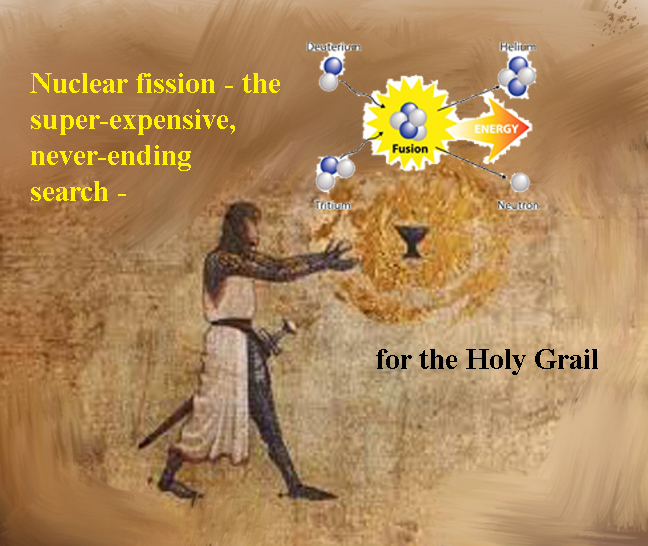Adam Tooze: Why Nuclear Fusion Is Not the Holy Grail

Of course, the amount of energy necessary to generate the laser beam is multiples larger—in the case of this laser beam, somewhere between 150 times larger than the amount that actually reaches the fuel materials. So this is still a powerfully net negative reaction that we have going on here; it uses more energy than it produces
It’s directly related to the military industrial complex, and so the synergies are there. It’s also very expensive; it requires a lot of capital investment, so the engineering companies like getting in on this.
A recent breakthrough is good news, but renewables are still the better bet.
FP.com By Cameron Abadi, a deputy editor at Foreign Policy. 9 Jan 23
Last month in California, a nuclear reactor produced 3.15 megajoules of energy using only 2.05 megajoules of energy input. That surplus has been treated as a major breakthrough in the future of energy because it was produced through the process of nuclear fusion. Experts have talked for decades about nuclear fusion’s potential as a carbon neutral source of energy without any of nuclear energy’s toxic waste.
What were the economics behind this breakthrough technology? Might it provide a status boost to old-fashioned engineering relative to computer engineering? And what’s the path from laboratory success to industrial use? Those are a few of the questions that came up in my recent conversation with FP economics columnist Adam Tooze on the podcast we co-host, Ones and Tooze. What follows is an excerpt, edited for length and clarity.
For the full conversation, look for Ones and Tooze wherever you get your podcasts.
………………… Adam Tooze: It’s a project that goes back originally to some really far-out thinking in the 1950s about uses that could be made of atomic bombs for the purposes of power generation. And the original idea was literally to organize a continuous stream of atomic explosions underground—you know, find some suitably stable caves, and explode several atomic bombs a day to keep a huge mass of water boiling to generate lots of steam. Anyway, that’s where it started.
But out of all of this, from the late 1960s onward, came more serious programs in fusion energy, which essentially focused on lasers. And that’s what this National Ignition Facility is—it is the ultimate fire lighter, right? Basically it’s a gigantic torch or something—the sort of effect that you generate as a Boy Scout or a Cub Scout or whatever, when you start a fire by concentrating the heat of the sun using a magnifying glass. So that’s essentially what we’re doing. And the stunning success of the current round of experiments announced by the U.S. Department of Energy to the public a few weeks ago now is that now for the first time ever, the amount of energy generated by the fusion reaction is larger than the amount of energy fired at it by the laser.
Of course, the amount of energy necessary to generate the laser beam is multiples larger—in the case of this laser beam, somewhere between 150 times larger than the amount that actually reaches the fuel materials. So this is still a powerfully net negative reaction that we have going on here; it uses more energy than it produces……….
CA: How long are we still from having fusion as a workable source of energy? What is the path generally from basic research to industrial use?
AT: I think the only honest answer to this in general is that we do not know the answer to this. You know, there was somebody talking to the New York Times and it really took me aback because this expert assumed that the answer was half a century away. …. it could easily be many decades.
……….. AT: I think, fundamentally- it’s gee whiz, final frontier, extraordinary stuff. And the physics involved are mind-blowing; the engineering is crazy and so much more exciting than just a solar panel sitting beat up in a field somewhere or on a roof or a windmill slowly turning.
It’s directly related to the military industrial complex, and so the synergies are there. It’s also very expensive; it requires a lot of capital investment, so the engineering companies like getting in on this. You know, as much as this National Ignition Facility is a public project, the $3.5 billion were mainly not spent on scientists. It was mainly spent on extremely complex raw materials and labor necessary to build the facilities, and much of that goes to the private sector. So there was a huge private sector stake in these kinds of projects.
But having said all of that, our experience both at the level of economics and at the level of politics with this particular set of technologies—those to do with nuclear power, fission, and fusion—over the last 50 years has been sobering. And on the whole, they appear at this point to be both massively unpopular technologies and, in some cases, hugely politicized technologies as well as incredibly expensive in terms of capital costs—not in terms of operating them but in terms of capital cost to build them.
…………… it’s pretty difficult to see what the case is for investing in new capacity when the costs are as explosively uneconomic.
So that is why I find it difficult to make the case for either conventional atomic power or fusion power as an immediately practical or relevant answer to the issues facing Western countries in the chase for a solution to the problem of the energy transition and decarbonization. And we are lucky, extraordinarily lucky, that renewable technologies have come on as quickly as they have. We should double down on this. We should invest even more.
CA: Can this kind of breakthrough serve to raise the status of materials engineering relative to computer engineering or even financial engineering? Is the old-fashioned kind of engineering in need of that kind of status boost in our society?
AT ………..I actually looked at the data for the National Science Foundation, and it turns out that among Ph.D.s of all types, it’s the humanities and the social sciences that we need to worry about because the share of doctorates in engineering—and this is distinct from computer science—is in fact on the rise and has been very dramatically over the last 20 years…. https://foreignpolicy.com/2023/01/08/adam-tooze-why-nuclear-fusion-is-not-the-holy-grail/
No comments yet.
-
Archives
- April 2024 (300)
- March 2024 (335)
- February 2024 (345)
- January 2024 (375)
- December 2023 (333)
- November 2023 (342)
- October 2023 (366)
- September 2023 (353)
- August 2023 (356)
- July 2023 (363)
- June 2023 (324)
- May 2023 (344)
-
Categories
- 1
- 1 NUCLEAR ISSUES
- business and costs
- climate change
- culture and arts
- ENERGY
- environment
- health
- history
- indigenous issues
- Legal
- marketing of nuclear
- media
- opposition to nuclear
- PERSONAL STORIES
- politics
- politics international
- Religion and ethics
- safety
- secrets,lies and civil liberties
- spinbuster
- technology
- Uranium
- wastes
- weapons and war
- Women
- 2 WORLD
- ACTION
- AFRICA
- Atrocities
- AUSTRALIA
- Christina's notes
- Christina's themes
- culture and arts
- Fuk 2022
- Fuk 2023
- Fukushima 2017
- Fukushima 2018
- fukushima 2019
- Fukushima 2020
- Fukushima 2021
- general
- global warming
- Humour (God we need it)
- Nuclear
- RARE EARTHS
- Reference
- resources – print
- Resources -audiovicual
- World
- World Nuclear
- YouTube
-
RSS
Entries RSS
Comments RSS






Leave a comment